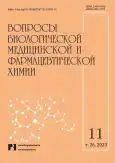Влияние высокотемпературной обработки на адсорбционные свойства природной голубой глины
- Авторы: Кормишина А.Е.1, Маркевич М.П.1
-
Учреждения:
- Ульяновский государственный университет
- Выпуск: Том 26, № 11 (2023)
- Страницы: 15-18
- Раздел: Фармацевтическая химия
- URL: https://journals.eco-vector.com/1560-9596/article/view/623558
- DOI: https://doi.org/10.29296/25877313-2023-11-03
- ID: 623558
Цитировать
Полный текст
Аннотация
Актуальность. Природные минеральные глины широко используются не только в технике, но и в медицине, косметологии, пищевой промышленности, благодаря своим уникальным свойствам. Высокая степень дисперсности, сорбционно-адгезивные свойства глинистых материалов, а также богатый минеральный состав определяют также их лечебное действие.
В зависимости от области и цели использования, глины подвергаются термической обработке, которая может привести к изменению их свойств.
Цель работы - изучение влияния различных режимов термообработки на сорбционные свойства глины для дальнейшего использования ее в фармацевтической практике.
Материал и методы. Объект исследования – глина кимериджская голубая порошкообразная Ундоровского месторождения Ульяновской области. Определение влажности глины проводили при помощи анализатора влажности AND MF–5 (Япония). Для полного удаления влаги из глины путем высокотемпературной обработки использовали электропечь SNOL 7.2/1100 (Литва). Влияние режима прокаливания глины на термическую устойчивость порошка глины и протекающих эндо- и экзотермических эффектов с потерей массы образцов исследовали на дериватографе Q-1500D (Венгрия). Адсорбционную активность оценивали методом прямой спектрофотомерии на спектрофотометре СФ-56 «ЛОМО-Спектр» (Россия).
Результаты. Дифференциальный термогравиметрический анализ дериватограмм показал термическую устойчивость порошка глины в интервале температур от 20 °С до 900 °С с различными вариациями эндо- и экзотермических эффектов. На основании этих данных выбраны режимы термообработки и время экспозиции образцов. Эксперимент показал статистически значимое снижение асдсорбционной активности при увеличении температуры при различных вариациях времени экспозиции.
Выводы. Для сохранения адсорбционных свойств Ундоровской голубой глины при удалении влаги из нее нерационально применять высокотемпературную обработку. Наиболее оптимальными параметрами сушки глины являются: температура 80 °С, время экспозиции - 240 мин.
Ключевые слова
Полный текст
Об авторах
А. Е. Кормишина
Ульяновский государственный университет
Автор, ответственный за переписку.
Email: allkorm@mail.ru
к.фарм.н., доцент кафедры общей и клинической фармакологии с курсом микробиологии
Россия, г. УльяновскМ. П. Маркевич
Ульяновский государственный университет
Email: allkorm@mail.ru
к.фарм.н., доцент, зав. кафедрой общей и клинической фармакологии с курсом микробиологии
Россия, г. УльяновскСписок литературы
- Жилякова Е.Т., Бондарев А.В. Изучение морфологии и пористой структуры медицинских глин. Фармация и фармакология. 2014; 2: 35.
- Кормишина А.Е., Мизина П.Г., Кормишин В.А. Исследование возможности использования природных сорбентов в фармацевтической технологии. Научн. диалог. Вопросы ме-дицины: материалы XIV международной научно-практической конференции. Санкт-Петербург. 2018; 1(2): 47–50.
- Государственная фармакопея ХIII издания. Т. 1. [Электронный ресурс]. МЗ РФ. М., 2015. Режим доступа: http://193.232.7.107/feml.
- Маркелов Д.А., Ницак О.В., Геращенко И.И. Сравнительное изучение адсорбционной активности медицинских сорбентов. Химико-фармацевтический журнал. 2008; 7(42): 3033.
- Брызгалова Л.В. Получение алюмосиликатных сорбентов и катализаторов на основе глинистых минералов и тестирование их cвойств: Автореф. дисс. … канд. техн. наук. Томск, 2009. 23 с.
Дополнительные файлы






